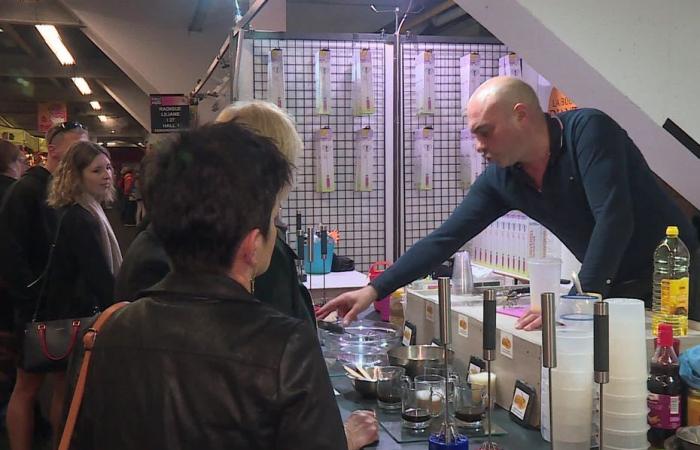
The Dijon fair is in full swing. From October 31 to November 11, nearly 400 exhibitors are gathered at the exhibition center. But with the rising costs linked to the event and the economic context, how do they manage to survive?
The essentials of the day: our exclusive selection
Every day, our editorial team reserves the best regional news for you. A selection just for you, to stay in touch with your regions.
France Télévisions uses your email address to send you the newsletter “The essentials of the day: our exclusive selection”. You can unsubscribe at any time via the link at the bottom of this newsletter. Our privacy policy
In Dijon, it's hard to miss the fair. From October 31 to November 11, the exhibition center is stormed by numerous visitors. Whether they are simply curious or informed buyers, they are all potential customers for the 400 exhibitors of this 112e edition.
This year, the fair attracted nearly 400 exhibitors, including 70 new ones.
•
© Guillaume Robin / France Télévisions
But this year, costs for traders have been revised upwards. To secure a place on a stand this year, the price is between 150 and 210 euros per square meter, an increase of almost 5% compared to last year. Here's how exhibitors are doing to stand out and amortize these new expenses.
For some, the answer lies in the very essence of the profession. So you have to perfect the basics. Nelson Halabi comes from Montpellier. When he is behind his stand, he is much more than just an exhibitor, he is a living spectacle. In addition to juice extractors, the Montpellier resident offers a detailed demonstration, of which he is very proud: “My job is demonstrator. There is a basis that I wrote, but it is done a lot in improvisation. I come to seek the energy of my audience, if I am efficient it is because the audience is receptive.”
With a tomato in hand, Neslon Halabi captivates his audience to praise the merits of his juice extractor.
•
© Guillaume Robin / France Télévisions
Through dynamic gestures and well-found plays on words, Nelson captivates passers-by who almost systematically stop as if caught up in the scene proposed. And many are putting their hands in their wallets, visibly convinced by the product or at least by the demonstration.
However, looking at the rest of the fair, not all exhibitors choose this technique which recalls the bustling markets of the south of France. “At the time there were 300 demonstrators, today you can see, our profession has taken a real hit”regrets Nelson. “There must be around forty of us working hard now, so it’s important to bring this profession back to life.”
For others, more than the technique, it is the entire organization that must now be thought about. Vanessa Pesquié opted for a solution that will allow her to save money over the duration of the event.
The Polynesian art exhibitor joined forces with around fifteen colleagues to form a Polynesian cultural association. She explains: “We are several Polynesian artisans and several of us came in force. We are offering a complete Polynesian village. It's a way of lowering prices because we are pooling locations. We are taking a larger location with several people and On the other hand, we have to bring something cultural.”
Vanessa Pesquié, Polynesian exhibitor, came with around fifteen other exhibitors to form a Polynesian village at the Dijon fair.
•
© Guillaume Robin / France Télévisions
In this village of exhibitors, there is a stage for artistic performances, initiations to making crowns or even culinary tastings. This organization was proposed by Dijon Bourgogne Events, the organizers of the fair. Without this proposal, it would have been difficult for this exhibitor to travel to Dijon: “It’s artisanal so I can’t lower the prices. It’s still a cost for very small structures like mine.”
For fifteen days of the fair, the cost comes to 2,500 euros in fixed costs, not including the merchandise for Vanessa Pesquié.
For 35 years, Catherine has been one of the exhibitors at the Dijon fair. This year, this carpet seller displays a superficial smile. The start of the fair does not look very successful, the public holidays have not helped, according to her, but there is something else.
The increase in prices per square meter, as in many other fairs, is a blow to exhibitors. “Purchasing power, the prices of all products, services are like that”she denounces. “We accept or we don't come. It's getting complicated. The fixed costs are heavy now. We pay attention to that when we agree to come and exhibit.”
Catherine is an exhibitor from Normandy.
•
© Guillaume Robin / France Télévisions
For this experienced saleswoman, these new prices are responsible for the scarcity of a certain clientele: “We see a middle class that has less power. They were our clients, our consumers… It's a national phenomenon.” All these new rules impose a different game for traders. Catherine is one of those who are forced to cut their margins. Its prices have increased by one or two euros, but it limits the damage. “We have reduced our margins so we are trying to eat at the stand.”
Like this exhibitor, many professionals in the sector are afraid of what the future holds for them.





